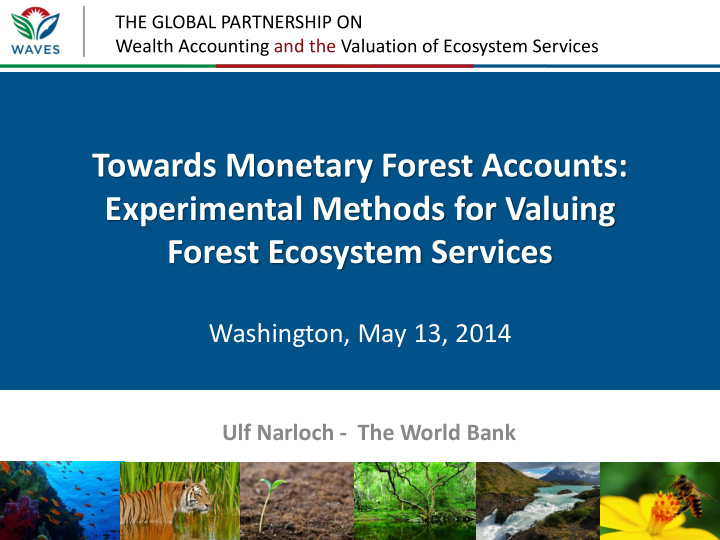



THE GLOBAL PARTNERSHIP ON Wealth Accounting and the Valuation of Ecosystem Services Towards Monetary Forest Accounts: Experimental Methods for Valuing Forest Ecosystem Services Washington, May 13, 2014 Ulf Narloch - The World Bank
1. Why it is important? • a single measurement unit is needed to aggregate/compare different benefits and costs • monetary units are a commonly-used decision-making metric • what can valuation achieve? 1. raising awareness and mainstream their value into decision-making 2. undertake a full economic evaluation of land use decisions 3. design economic incentive instruments (e.g. payment for ecosystem services) 4. derive total economic value of forests and its contribution to the economy 5. augment SNA estimates (e.g. depletion adjusted, green GDP) 6. calculate improved macro-economic sustainability indicators (e.g. comprehensive wealth, genuine savings)
2. What to value? forest ecosystem forest land forest benefits services • benefits forests provide for humans = final goods and services that generate utility and alter human welfare • values depends on who benefits where variety of beneficiaries – in different sectors • forestry (e.g. logging, wood, etc) • non-forestry (e.g. agriculture, energy, water, tourism, etc) – across different scales • local (e.g. forest land user, downstream municipality) • national (e.g. industries, governments) • global (e.g. international community)
2. What to value? forest benefits Forest Ecosystem Services* Examples: Forest Benefits timber timber firewood/ charcoal wood-based energy provisioning non-timber forest products (NTFP) food, fodder, medicine services genetic material product development grazing livestock feeding pollination agricultural production water flow regulation hydro-power production regulating soil retention and formation sedimentation control services water cycle regulation (drinking) water supply atmospheric/climate regulation carbon storage/ sequestration recreation tourism information and knowledge research/ education cultural Services cultural heritage, identity, spiritual/ spiritual & symbolic religious functions non-use existence/ bequest * according to the Common International Classification of Ecosystem Services for the SEEA Experimental Ecosystem Accounting
2. What to value? 1. direct market benefits : final forest goods & services that can be traded in markets – goods produced for the market (e.g. timber, firewood/charcoal, NTFP) – goods produced for self-consumption/informal exchange (e.g. timber, firewood/charcoal, NTFP) – regulating services with a market price (e.g. through carbon trading/tax, PES) 2. indirect (quasi-) market benefits contribute to production of market goods and services by other economic activities (agriculture, energy, water, tourism) – attribute of a heterogeneous non-forest market good (e.g. recreation, information/knowledge) – complementary input in non-forest production (e.g. genetic material, grazing, pollination, water flow/cycle regulation, soil retention) – substitute-input in non-forest production (e.g. water flow/cycle regulation, soil retention) 3. non-market benefits : services that do not contribute to market goods and services – other regulating services – cultural benefits (e.g. cultural heritage, local identities, spiritual or religious benefits) – non-use benefits (bequest, altruist and existence values)
Valuation principles 3.1 How to value? • approaches to value forest land (according to SNA): – land value observed at markets – replacement costs – net present value of future returns • exchange value concept to make values compatible with SNA – monetary value at which goods or services are in fact exchanged or else could be exchanged for cash • market prices • market-price equivalents • production costs – ≠ welfare economic value concept : full marginal value that accrue to society today and in the future • shadow prices that reflect market inefficiencies and constraints • social prices that account for externalities and public goods
Valuation techniques 3.2 How to value? method market benefits indirect (quasi-) non-market market benefits benefits resource rent X 1. market- based production costs X replacement costs X X damage costs X 2. revealed preference production function X hedonic pricing X travel costs X preference contingent valuation X X 3. stated choice experiment X X 4. benefit transfer X X X
4. What do we need? • overcome political resistance (‘commodification of nature’) • technical capacities and extensive data to make valuation compatible with SNA • methods need to advance to: 1. incorporate marginal value concept 2. account for non-linear relationships/thresholds 3. understand spatial relationships 4. dealing with uncertainty 5. avoid double-counting • acknowledge contribution of forests to wider social values and multiple dimensions of human well-being
Thank you! unarloch@worldbank.org
Recommend
More recommend